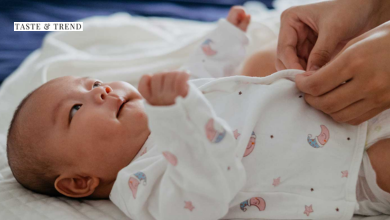How to Dress a Baby for Sleep A Safe and Simple Guide for Parents

One of the most frequent worries that new parents have is dressing their child for sleep. Babies aren’t able to tell you when they’re getting too cold or hot, and so finding the right balance can be difficult. The aim is to ensure that your child is at ease and secure during their sleepnot too hot but yet not cold.
This article will help you make the baby safest sleepwear options and tips for room temperature and general guidelines for dressing in accordance with the seasons.
Why Sleep Temperature Matters
Infants, particularly newborns are still learning about how to manage their body temperatures. It is important to dress them correctly to: how to dress baby for sleep:
- Comfort — A better night’s sleep and less wake-ups
- Safety Overheating is a well-known risk cause in Sudden Infant Death Syndrome (SIDS)
The most secure sleeping arrangement:
A baby sleeping on their back in the naked crib (no pillows or toys) with suitable layers.
General Rule: One More Layer Than You
A good guideline is dressing your child in one additional layer than you would wear to bed in the same space.
If you’re comfortable in your pajamas with a bed sheet or blanket, your child could wear a onesie with a sleep sack or a light swaddle.
Baby Sleepwear Options
Here are some safe, standard baby items for sleepwear:
- Onesie or bodysuit (short or long sleeve)
- Sleeper with feet or pajamas for sleep and play
- Wearable blanket/sleep bag (tog-rated)
- Swaddle (for infants who haven’t started rolling yet)
Avoid: Blankets that are loose, hats, and heavy quilts for the crib.
Dressing Baby by Room Temperature
| Room Temperature | Suggested Sleepwear |
| 75-80degF (24-27degC) | Lightweight onesie or short-sleeve bodysuit |
| 70-74degF (21-23degC) | Cotton sleeper or footed pajamas |
| 65-69degF (18-20degC) | Pajamas + sleep sack (1.0-2.5 TOG) |
| 60-64degF (15-17degC) | Pajamas + a large sleep bag (2.5 TOG) |
TOG = Thermal Overall Grade, which is the degree of warmth a sleep bag (or wearable blanket) is.
Swaddling Tips (For Newborns)
If your baby is less than 2 months and hasn’t started getting up and walking Swaddling can make your baby feel safe.
- Utilize use a lightweight, breathable swaddle sack as well as a sleep sack with a swaddle
- Stop swaddling when the baby starts to roll typically at around 8 weeks.
Signs Baby Is Too Hot or Cold
Too Hot:
- Sweating
- Hair that is damp
- Flushed cheeks
- Rapid breathing
- Itchy rash from the heat
Too Cold:
- Cold feet and hands (mildly acceptable)
- Skin that is pale or blotchy
- Fussiness, trouble settling
Take a look at baby’s chest and neck (not feet or hands) — to gauge the warmth.
What About Winter?
In winter, colder weather:
- Make use of layering clothes such as a bodysuit and pajamas with feet and a warm sleep sack
- Maintain the room temperature between 68 and 72degF (20-22degC)
- Do not use space heaters close to the crib.
- Don’t cover the baby’s head while they are sleeping.
What About Summer?
In the warmer months:
- Utilize an onesie with a shorter sleeve or an underwear underneath a sleep sack that is light
- Beware of sleepwear or swaddles that hold heat
- Make use of the fan to circulate air however, not directly onto the baby.
Final Tips
- Always observe safe sleeping rules: Back to sleep with a firm mattress, and no clutter
- Make use of the most breathable fabrics such as bamboo or cotton
- Adjust layers if your baby is suffering from an fever or isn’t sleeping properly.
- If you are unsure, opt to make sure to go lighter instead of heavier
Quick Recap: Dressing Baby for Sleep
Make sure you have a second layer on top of the one you normally wear.
Wear fabric that breathes
Avoid wearing blankets and hats in the crib.
Make adjustments according to the temperature of the room.
stop swaddling when baby begins rolling